Important Question for Class 10 Science How Do Organisms Reproduce PDF will help you in scoring more marks.. This consists of 1 mark Questions, 3 Mark Numericals Questions, 5 Marks Numerical Questions and previous year questions from How Do Organisms Reproduce Chapter.
How Do Organisms Reproduce?Chapter Wise Important Questions Class 10 Science
SHORT ANSWER TYPE QUESTIONS [3 Marks] – Year 2007
Question. 1(i) What is fertilisation? Distinguish between external fertilisation and internal
fertilisation.
(ii) What is the site of fertilisation in human beings?
Answer.
(i) Fertilisation is defined as the fusion of a male gamete (sperm) with a female gamete (an ovum or egg) to form a zygote during sexual reproduction.
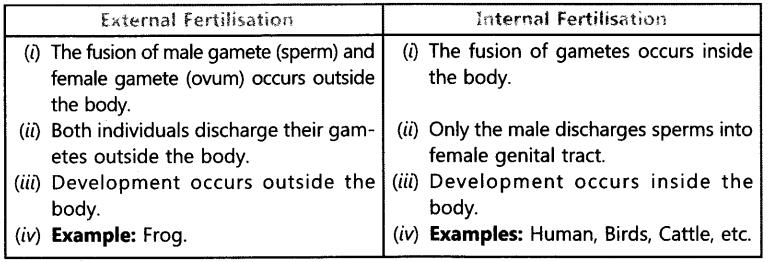
(ii) The site of fertilisation in human beings is in the fallopian tube of female reproductive system.
CBSE Class 10 Science – More Resources
| NCERT Solutions for Class 10 Science | NCERT Exemplar Class 10 Science |
| CBSE Class 10 Previous Year Question Papers | Class 10 Science Important Questions |
Question.2 Define the terms unisexual and bisexual giving one example of each.
Answer. Unisexual is the plant whose flowers contain either stamens or carpels but not both. Example: Papaya, Watermelon.
Bisexual is the plant whose flowers contain both stamens and carpels. Example: Hibiscus, Mustard.
Question.3 Differentiate between ‘self-pollination’ and ‘cross-pollination’. Describe double fertilisation in plants.
Answer.

During fertilisation in plants, the following events take place:
(i) One of the male gamete fuses with the female gamete present in the embryo sac.
(ii) The other male gamete fuses with the two polar nuclei in the embryo sac.
The first fusion product gives rise to the zygote while the second one forms the endosperm.
The process of two fusions occurring in the embryo sac is called double fertilisation.
VERY SHORT ANSWER TYPE QUESTION [1 Mark] – Year 2008
Question.4 What is the effect of DNA copying which is not perfectly accurate on the reproduction process?
Answer. DNA copying is not perfectly accurate and the resultant errors are a source of variations in populations of organisms.
SHORT ANSWER TYPE QUESTIONS [2 Marks] – Year 2008
Question.5 What is ‘reproduction’? Mention the importance of DNA copying inreproduction.
Answer. Reproduction is the process of producing new individuals of the same species
by existing organisms of a species, i.e. parents. The importance of DNA copying in reproduction are as follows:
(i) DNA copying is called DNA replication. In this process, one copy each of replicated DNA will be passed to daughter cells.
(ii) Variations may be introduced during DNA copying. This inbuilt tendency for variation during reproduction forms the basis of evolution.
Question.6 “Variations that confer an advantage to
an individual organism only will survive in a population.” Justify.
Answer. It is because the chances of survival depend on the nature of variations and different individuals have different kinds of advantages.
For example, a bacteria that can withstand heat will survive better in a heat wave, i.e. the organisms that are fit in the competitive environment and with great variations will be able to survive and adapt. Thus, more offsprings and population with genetic variations will survive.
Question.7 Name one sexually transmitted disease
each caused due to bacterial infection and viral infection. How can these be prevented?
Answer. Sexually transmitted disease caused due to
(i) Bacterial infection is gonorrhoea, and
(ii) Viral infection is AIDS (Acquired Immune Deficiency Syndrome). These diseases can be prevented by responsible sexual behaviour such as use of condom during intercourse, etc.
Question.8(a) In the human body what is the role of
(i) seminal vesicles, and (ii) prostate gland?
(b) List two functions performed by testis in human beings.
Answer. (a) The role of seminal vesicles and the prostate gland are as follows:
(i) Seminal vesicles produce seminal plasma which is in the form of fluid makes the transport of sperms smooth.
(ii) Prostate gland secretes prostatic fluid that keeps the sperms alive and helps them to swim vigorously.
(b) Two functions performed by testis
in human beings are as follows:
(i) Formation of sperms takes place in testis.
(ii) They secrete the hormone testosterone which regulates the formation of sperms and brings changes in appearance of boys at the time of puberty.
SHORT ANSWER TYPE QUESTK)NS[II] [3 Marks] – Year 2008
Question.9 Illustrate the following with the help of suitable diagrams:
(i) Regeneration in Planaria.
(ii) Budding in Hydra.
Answer.
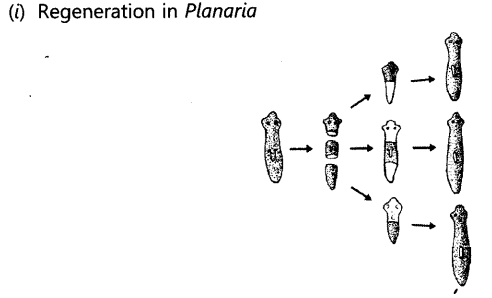

Question.10 Illustrate the following with the help of suitable diagrams:
(i) Binary Fission in Amoeba.
(ii)Leaf of Bryophyllum with buds.
Answer.
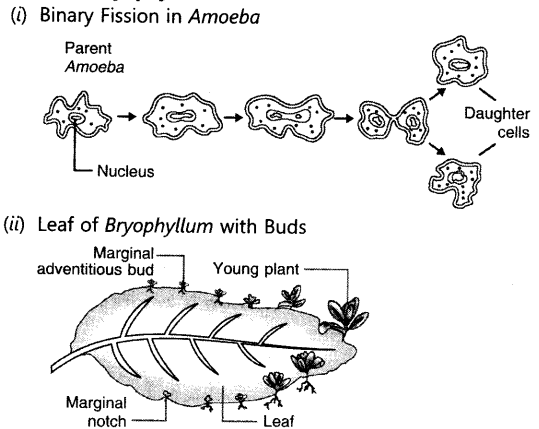
Question.11 Illustrate the following with the help of suitable diagrams:
(i) Spore formation in Rhizopus.
(ii)Multiple fission in Plasmodium.
Answer.


LONG ANSWER TYPE QUESTIONS [5 Marks] – Year 2008
Question.12 (a) Name the parts labelled A, B, C, D and E.

(b) Where do the following functions occur?
(i) Production of an egg
(ii) Fertilisation
(iii) Implantation of zygote.
(c) What happens to the lining of uterus:
(i) before release of a fertilised egg?
(ii) if no fertilisation occurs?
Answer. (a)
A – Oviduct or Fallopian tube;
B – Ovary;
C – Uterus;
D – Cervix;
E – Vagina.
(b) (i) Ovaries; (ii) Fallopian tube;
(iii) Lining of the uterus.
(c) (i) The lining of uterus becomes
(ii) The lining of uterus slowly breaks and comes out through the vagina as blood and mucous, if no fertilisation occurs.
Question.13(a) Draw a diagram showing
germination of pollen on stigma of a flower.
(b) Label pollen grain, male germ- cells, pollen tube and female germ-cell in the above diagram.
(c) How is zygote formed?
Answer. (a) and (b)

(c) Zygote is formed when male gamete, Le. sperm fuses with female gamete, i.e. ovum.
VERY SHORT ANSWER TYPE QUESTIONS [1 Mark] – Year 2009
Question.14 Mention the mode of reproduction used by
(a) Amoeba (b) Planaria.
Answer. Mode of reproduction used by
(a) Amoeba is Binary fission.
(b) Planaria is Regeneration.
Question.15 Name the information source of making proteins in the cell. State two basic events in reproduction.
Answer. The DNA in the cell nucleus is the information source of making proteins.
The two basic events in reproduction are:
(i) Creation of a DNA copy,
(ii) Additional cellular apparatus by the cell involved in the process.
Question.16 State the method used for growing rose
plants.
Answer. Artificial methods of vegetative propagation like cutting are used to grow rose plants.
Question.17 State what type of method is used for
growing jasmine plant.
Answer. Artificial methods of vegetative propagation like layering is used for growing jasmine plant.
Question.18 Name the largest cell present in the
human body.
Answer. The largest cell present in the human body is ovum.
SHORT ANSWER TYPE QUESTIONS [I] [2 Marks] – Year 2009
Question.19 What is regeneration? State a reason why a more complex organism cannot give rise to new individuals through this method.
Answer. Regeneration is the ability of a fully differentiated organism to give rise to new individual organisms from its body parts. More complex organisms cannot give rise to new individuals through regeneration because:
(i) their body is highly complicated.
(ii) there are specific organs to do specific functions.
(iii) there is a labour division in the body of complex organisms.
(iv) regeneration is carried out by specialised cells which are not present in complex organisms.
Question.20 What is reproduction? What are its two types? Which one of the two confers new characteristics on the offsprings and how?
Answer. Reproduction is the process of producing new individuals of the same species by existing organisms of a species, z.e. parents. Its two types are: Asexual reproduction and Sexual reproduction.
Sexual reproduction confers new characteristics on the offspring due to variation in DNA copying.
SHORT ANSWER TYPE QUESTIONS][II] [3 Marks] – Year 2009
Question.21(a) Explain the terms:
(i) Implantation (ii) Placenta
(b) What is the average duration of human pregnancy?
Answer. (a)
(i) Implantation: The embedding
of a fertilised mammalian egg (embryo) into the inner thick wall of the uterus (womb) where it will continue its development is called implantation.
(ii) Placenta: It is a complex double-layered spongy vascular tissue in human female formed by the joint activity of maternal and foetal tissues in the wall of uterus that is meant for attachment, nourishment and waste disposal for the foetus.
(b) The average duration of human pregnancy is 40 weeks or 280 days.
Question.22 What are sexually transmitted diseases?
Name four such diseases. Which one of them damages the immune system of human body?
Answer. Sexually Transmitted Diseases (STDs) are the diseases which are spread by sexual contact from an infected person to a healthy person. They are caused by various microorganisms that live in warm and moist environments of the vagina, urethra, anus and mouth.
The four sexually transmitted diseases are:
(i) Gonorrhoea
(ii) Syphilis
(iii) Trichomoniasis
(iv) AIDS (Acquired Immune Deficiency Syndrome).
AIDS damages the immune system of human body.
SHORT ANSWER TYPE QUESTION[I] [2 Marks] – Year 2010
Question.23 List any four reasons for vegetative propagation being practised in the growth of some type of plants.
Answer.
(i) Vegetative propagation is a cheaper, easier and more rapid method of propagation in plants than growing plants from their seeds.
(ii) Better quality of plants can be maintained by this method.
(iii) It results in propagation of those plants which do not produce viable seeds or produce seeds with prolonged period of dormancy.
(iv) The plants generated from vegetative means are more uniform and genetically similar to the parent stock.
SHORT ANSWER TYPE QUESTIONS][II] [3 Marks] – Year 2010
Question.24 Write the full form of DNA. Name the part of the cell where it is located. Explain its role in the process of reproduction of the cell.
Answer. The full form of DNA is deoxyribonucleic acid. It is the genetic material found in the chromosomes, which are present in the nucleus of a cell.
Role of DNA in the process of repro¬duction of the cell:
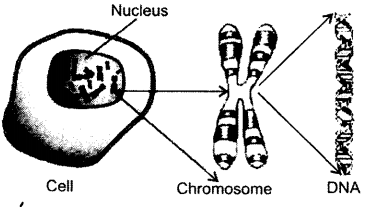
DNA plays an important role in the reproduction of a cell. The reproducing cell produces an identical copy of DNA through some cellular mechanism. Since the newly formed copy of DNA lacks an organised cellular structure, the cell gets divided to provide cell cover to the newly formed DNA. Thus, two daughter cells are formed from the single cell as a result of the copying of DNA.
Question.25 Explain vegetative propagation with the help of two examples. List two advantages of vegetative propagation.
Answer. In vegetative propagation, new plants are obtained from the parts of old plants like stems, roots and leaves, without the help of any reproductive organ.
There are two ways of vegetative propagation:
(a) Natural Vegetative Propagation, and
(b) Artificial Vegetative Propagation.
Natural vegetative propagation by leaves: The fleshy leaves of Bryophyllum bear adventitious buds in the notches along the leaf margin.
Grafting: In this method of reproduction, two plants of closely related varieties are joined together so that they live as one plant.
- The portion of a plant that is grafted on the other plant is called scion, and the plant in which grafting is performed is called the stock.
- This method is applied to improve variety of fruits like mango, apple, peas, citrus and guava.
advantages of vegetative propagation are:
(i) Vegetative propagation is a cheaper, easier and more rapid method of propagation in plants than growing plants from their seeds.
(ii) Better quality of the plants can be maintained by this method.
Question.26 List any three differences between pollination and fertilisation.
Answer.

LONG ANSWER TYPE QUESTIONS [5 Marks] – Year 2010
Question.27 Draw a longitudinal section of a flower and label the following parts:
(i) Part that produces pollen grain.
(ii)Part that transfers male gametes to the female gametes.
(iii) Part that is sticky to trap the pollen grain.
(iv) Part that develops into a fruit.
Answer.
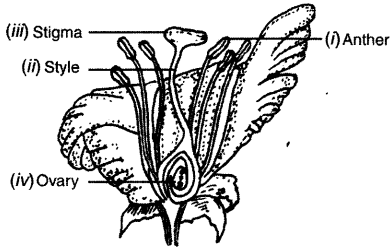
Question.28 (a) Explain the role of placenta in the
development of human embryo.
(b) Give example of two bacterial and two viral sexually transmitted diseases. Name the most effective contraceptive which prevents spread of such diseases.
Answer.
(a) Role of placenta in the development of human embryo: A special tissue develops between the uterine wall and the embryo (foetus) called placenta, where exchange of nutrients, glucose and oxygen takes place. The developing embryo will also generate waste substances which can be removed by transferring them into the mother’s blood through the placenta. The development of the child inside the mother’s blood takes approximately nine months.
(b) Sexually transmitted diseases (STDs) transmitted by bacteria are:
(i) Gonorrhoea (ii) Syphilis
STDs transmitted by virus:
(i) AIDS (ii) Genital warts
The most effective contraceptive which prevents the spread of these diseases is by the use of mechanical barriers such as physical devices like condoms.
SHORT ANSWER TYPE QUESTIONS [I] [2 Marks] – Year 2011
Question.29 Write any two differences between binary fission and multiple fission in a tabular form as observed in cells of organisms.
Answer.

Question.30 List any four modes of asexual reproduction.
Answer. Four modes of asexual reproduction are—Binary fission in Amoeba, Fragmentation in Spirogyra, Regeneration in Planaria and Budding in Hydra.
Question.31 Why is DNA copying an essential part of the process of reproduction?
Answer.DNA copying is an essential part of the process of reproduction because:
(i) DNA copying provides cellular apparatus in the daughter cells.
(ii) DNA in daughter cells will be able to control the functioning of daughter cells.
(iii)DNA copies will retain the traits.
SHORT ANSWER TYPE QUESTIONS [II] [3 Marks] – Year 2011
Question.33 What does HIV stand for? Is AIDS an infectious disease? List any four modes of spreading AIDS.
Answer. HIV stands for Human Immunodeficiency Virus.
Yes, AIDS is an infectious disease.
Four modes of spreading AIDS are as follows:
(i) By having sexual contact with an infected person.
(ii) By the transfusion of blood from an infected person.
(iii) Through infected needles used for injection.
(iv) Through the placenta from the mother to child during pregnancy.
Question.34 Expand AIDS. List any four methods of prevention (control) of AIDS.
Answer. AIDS stands for Acquired Immune Deficiency Syndrome.
Four methods of prevention or control of AIDS are as follows:
(i) Use condom during sex.
(ii) Avoid sharing of needles.
(iii) Test blood for AIDS before transfusion.
(iv) Avoid sexual contact with unknown person.
Question.35 (a) List any four reasons for adopting contraceptive methods.
(b) If a woman is using Copper-T, will it help in protecting her from sexually transmitted diseases? Why?
Answer. (a) Four reasons for adopting contra¬ceptive methods are:
(i) To increase the gap between, two children.
(ii)To prevent unwanted preg¬nancy.
(iii)To prevent transmission of STDs.
(iv)To control population growth. (b) If a woman is using a copper-T,
it will not help in protecting her from sexually transmitted diseases. Copper-T prevents only implantation in the uterus.
Question.36 Explain the following methods of contraception giving one example of each:
(i) Barrier method
(ii) Hormonal imbalance method
(iii) Surgical method.
Answer.
(i) Barrier Method: In this method, physical devices such as condoms, diaphragm and cervical caps are used. These devices prevent the entry of sperm in the female genital tract during copulation, thus acting ‘ as a barrier between them.
(ii) Hormonal Imbalance Method: In
this method, specific drugs are used by females, which are of two types: oral pills and vaginal pills.
Oral pills contain hormones which stop the ovaries from releasing ovum into the fallopian tube. These pills are also called oral contraceptives (OCs) which act by changing the hormonal balance of the body so that eggs are not released and fertilisation cannot occur. The use of Intrauterine Contraceptive Devices (IUCDs) prevents implantation in the uterus. This device is copper-T placed safely inside the uterus by a doctor or nurse.
(iii) Surgical Method: In this method, a small portion of vas deferens in male and the fallopian tube in ‘ female is surgically removed or tied. It is called vasectomy in males and tubectomy in females. In this case, if the vas deferens in male is blocked, sperm transfer will be prevented and if the fallopian tube in the female is blocked, the egg will not be able to reach the uterus, thus fertilisation will not take place.
LONG ANSWER TYPE QUESTIONS [5 Marks] – Year 2011
Question.37 (a) What is fragmentation in organism?
Name a multicell-ular organism which reproduces by this method.
(b) What is regeneration in organism? Describe regeneration in Planaria with the help of a suitable diagram.
Answer. (a) Fragmentation: Multicellular organisms with simple body organisation such as filamentous algae-Spirogyra breaks up into two or more small pieces or fragments upon maturation. These fragments grow into new individuals.
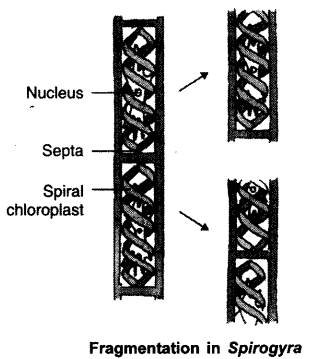
(b) Regeneration: It is the ability of a fully differentiated organism to give rise to new individual organisms from its body parts.
- Small cut or broken parts of the organism body grow or regenerate into separate individuals.
- Planaria can be cut into any number of pieces and each piece grows into a complete organism.
- Regeneration is carried out by specialised cells which proliferate and make large number of cells thus, undergoing changes to become various cell types and tissues.
- The changes taking place in an organised sequence is development.
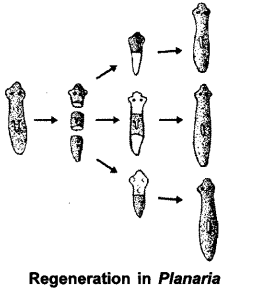
Question.38 With the help of suitable diagrams, explain the various steps of budding in Hydra.
Answer.
- Hydra reproduces by budding using the regenerative cells.
- A bud develops as an outgrowth in Hydra due to repeated cell division at one specific site.
- When fully matures, the bud detaches itself from the parent body and develops into new indipendent individuals

Question.39 (a) What is spore formation?
(b) Draw a diagram showing spore formation in Rhizopus.
(c) List two advantages for organisms
to reproduce themselves through spores.
Answer.
(a) When a slice of bread is kept in moist dark place for a few days, spores of Rhizopus present in air settle on the bread to form new fungus plants of Rhizopus.
(b) The Rhizopus consists of fine thread-like projections called hyphae. It has a knob like structure which is involved in reproduction called sporangia, containing spores, that develop into new Rhizopus.
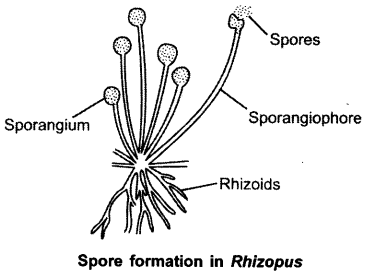
(c) Two advantages for organisms to reproduce themselves through spores are as follows:
(i) It is a faster mode of reproduc-tion.
(ii) Offsprings produced are identical.
SHORT ANSWER TYPE QUEST10NS[I] [2 Marks] – Year 2012
Question.40 State one genetically different feature between sperms and eggs of humans. What is its consequence?
Answer. The sex chromosome of human male is XY. A sperm of human male carries either an X chromosome or one Y chromosome.
The sex chromosome of human female is XX and hence, the egg always carries the X chromosome.
If a sperm carrying X chromosome fertilises an egg which carries X chromosome, then the’ child born will be a girl. If a sperm
carrying Y chromosome fertilises an egg which carries X chromosome, then the child born will be a boy.
Question.41 List two advantages of vegetative reproduction practised in case of an orange plant.
Answer. Two advantages of practising vegetative reproduction in orange plants are:
(i) The oranges produced are similar in size and shape.
(ii) Many oranges do not produce viable seeds and hence, vegetative method is good alternative.
Question.42 How does growing embryo get nutrition from the mother’s blood?
Answer. The embryo gets nutrition from the mother’s blood with the help of a special tissue called placenta. This is a disc which is embedded in the uterine wall and transfers glucose and oxygen from the mother to the embryo.
Question.43 Define the term puberty. List two changes observed in girls at the time of puberty.
Answer. The period, when the rate of general body growth begins to slow down and reproductive tissues begin to mature, is called puberty.
Two changes observed in girls at the time of puberty are:
(i) The breast size begin to increase, (ii) Menstruation starts.
Question.44 What is meant by asexual reproduction? List its any two different forms.
Answer. Asexual reproduction is the process of producing new organism from a single parent without the involvement of sex cells. Fission and fragmentation are two different forms of asexual reproduction.
Question.45 Name an organism which reproduces by spore formation. List three conditions
favourable for spores to germinate and grow.
Answer. Rhizopus reproduces by spore formation. Conditions favourable for spore formation are:
(i) Cool place, (ii) Moist place and (iii) Dark place.
Question.46 “DNA copies generated during reproduction will be similar but may not be identical to the original.” Justify this statement.
Answer. DNA copies generated will be similar, but may not be identical to the original as some variations are so drastic that new DNA copy cannot work with the cellular apparatus it inherits. Such a newborn cell will simply die. Therefore, there could be many other variations in the DNA copies that would not lead to such a drastic outcome. Thus, the surviving cells are similar but slightly different from each other. This tendency of variation during reproduction is the basis for evolution.
Question.47 List two advantages of practising vegetative propagation in plants. Select two plants raised by this method from the list given below:
Banana, Gram, Pea, Rose, Tomato, Wheat.
Answer. Advantages of vegetative propagation are:
- Plants raised by vegetative propa-gation can bear fruits and flowers earlier.
- Plants produced are genetically similar.
Banana and Rose can be raised by vegetative method.
Question.48 List the parts of human male reproductive system which contribute fluid to the semen. State two advantages semen offers to the sperms.
Answer. Prostate glands and seminal vesicles add fluid in the vas deferens. This makes transportation of sperms easier and also provides nutrition to the sperms.
Question.49 Name the two types of germ-cells
present in human beings. How do they structurally differ from each other? Give two differences.
Answer. The two types of germ-cells present in human beings are sperm and ova. The sperm of human have either X or Y chromosome. The ova always carry X chromosome. The sperm is structurally long with a tail. The ova is round in structure.
SHORT ANSWER TYPE QUESTIONS[II] [3 Marks] – Year 2012
Question.50 List and explain in brief three methods of contraception.
Answer. Methods of contraception are:
- Use of condom for penis or for vagina as a mechanical barrier for the sperms to reach the egg.
- Use of oral pills which change the hormonal balance so that eggs are not released.
- Surgical method where either the vas deferens of male is blocked or the fallopian tube of female is blocked.
Question.51 What is AIDS? Which microbe is responsible for AIDS infection? State one mode of transmission of this disease. Explain in brief one measure for the prevention of AIDS.
Answer. AIDS is the Acquired Immune Deficiency Syndrome.
It is caused by a virus called Human Immunodeficiency Virus.
AIDS is transmitted by sexual contact with an infected person.
AIDS can be prevented by avoiding sexual contact with infected person or by using condom during sex.
LONG ANSWER TYPE QUESTIONS [5 Marks] – Year 2012
Question.52 Describe in brief the role of (i) testis (ii) seminal vesicle, (iii) vas deferens, (iv) ureter and (v) prostate gland in human male reproductive system.
Answer.
- Testis: Testes are oval shaped primary reproductive organs in men. The function of testes is to produce sperms and male sex hormone testosterone. The scrotum provides optimal temperature for the formation of sperms.
- Seminal vesicle: Seminal vesicles are a pair of thin walled muscular elongated sac which secrete fluid for nourishment of sperms.
- vas deferens: The sperms are carried by a long tube called vas deferens to organs called seminal vesicles where the sperms get nourishment and stored.
- Ureter It is the tube that carries urine from kidney to the urinary bladder. In humans, there are two ureters, one attached to each kidney.
- Prostate glands: Prostate glands produce a fluid which is released in the urethra along with secretion of seminal vesicles for nourishment and transportation of sperms.
Question.53 Draw a diagram of a human female reproductive system and label the part
(i) that produces egg
(ii) where fusion of egg and sperm take place
(iii) where zygote is implanted
What happens to human egg when it is not fertilised?
Answer.
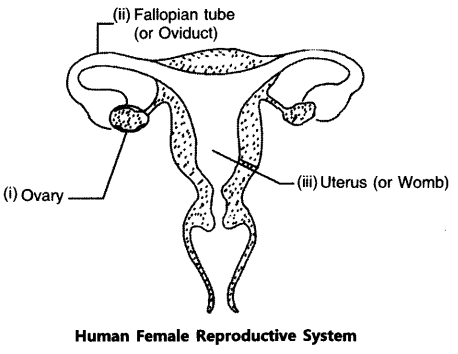
If the egg is not fertilised, the thick and nourishing lining of the uterus breaks and comes out through vagina as blood and mucous.
Question.54 State in brief the changes that take place in a fertilised egg (zygote) till birth of the child in the human female reproductive system. What happens to the egg when it is not fertilised?
Answer. The egg gets fertilised in the oviduct. The fertilised egg, the zygote gets implanted in the lining of the uterus and starts dividing. The uterus prepares itself every month to receive and nurture the growing embryo. The lining thickens and is richly supplied with blood to nourish the growing embryo.
The embryo gets nutrition from the mother’s blood with the help of a special tissue called placenta. The development of the child inside the mother’s body takes approximately nine months. On completion of 9 months, the child is born as a result of rhythmic contractions of the muscles in the uterus.
If the egg is not fertilised, the thick and nourishing lining of the uterus breaks and comes out through vagina as blood and mucous.
NCERT Solutions for Class 10
<!–
–>